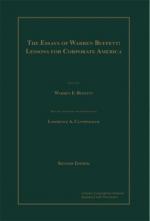
|
| Name: _________________________ | Period: ___________________ |
This test consists of 15 multiple choice questions and 5 short answer questions.
Multiple Choice Questions
1. A CEO unlikely to dispose of his successful operating business may sell profitable stock investments to redeploy _________.
(a) Dividends.
(b) Interest.
(c) Nothing.
(d) Capital.
2. What did a bondholder have to do with their bond if they decided to cash it in early?
(a) Pay interest.
(b) Transfer it back to the owner.
(c) Nothing.
(d) Earn more.
3. What was the title of Buffett's partner in the company they shared?
(a) Vice-Chairman.
(b) Chairman.
(c) CEO.
(d) Vice President.
4. Berkshire's board included a controlling ________, in which other board members could persuade others to make changes.
(a) Competitor.
(b) Shareholder.
(c) Owner.
(d) Outsider.
5. How many primary holdings were permanent in the time of Buffett and Munger?
(a) Four.
(b) Three.
(c) One.
(d) Two.
6. The partners considered a lesser interest if the ________ price was less than what it would be for 100%.
(a) Pro-management.
(b) Pro-biotic.
(c) Pro-rate.
(d) Pro-rata.
7. Most Berkshire _______ had their net worth invested primarily in the company.
(a) Workers.
(b) Secretaries.
(c) Shareholders.
(d) Directors.
8. Buffett's criteria measured _________ expectations of the highest after-tax returns to maximize net worth in the long run.
(a) Mathematical.
(b) Probable.
(c) Emotional.
(d) Accounting.
9. The margin of ________ was the cornerstone of investment success, according to Graham.
(a) Error.
(b) Reward.
(c) Safety.
(d) Risk.
10. How much profit did the new holding of Berkshire make for Buffett and Munger?
(a) $150M.
(b) $500M.
(c) $100M.
(d) $250M.
11. _________ percentage ownership was acquired when the market presented opportunities, according to the book.
(a) Greater.
(b) More.
(c) Lesser.
(d) Beholden.
12. Buffett disliked _________ because of its leverage, according to the book.
(a) Accounting.
(b) Stocks.
(c) Savings bonds.
(d) Banking.
13. How much was the company worth that Buffett and his partner created at the time of this book?
(a) $10M.
(b) $5M.
(c) $30M.
(d) $70B.
14. Who was the financial mentor that Buffett relied upon for his teachings and lessons about the way to do business?
(a) Ben Graham.
(b) Himself.
(c) Charlie Munger.
(d) No one.
15. Many stocks had a _______, like Coca-Cola, but none have the same market share.
(a) Risk.
(b) Manner.
(c) Beta.
(d) Price.
Short Answer Questions
1. Some Berkshire insurance subsidiaries used _______ with its greater returns than to use Treasury Bils.
2. Which state was Buffett worried about in terms of its ability to create good investments for his company?
3. The long-term economic goal was to maximize per-share average annual rate of gain at ______% of the intrinsic business value.
4. Buffett's long term economic goal was to maximize per share _________ value of Berkshire stock by owning a diversified group of businesses.
5. Risk ___________ was defined as the pursuit of profits from anticipated events, according to the book.
|
This section contains 398 words (approx. 2 pages at 300 words per page) |

|




